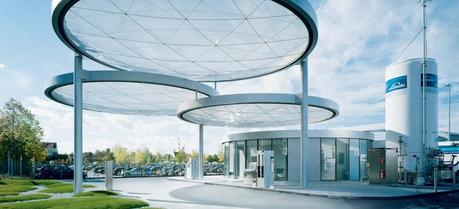 Linde Hydrogen Centre in Unterschleissheim, Germany. (Credit: Linde Group)
Linde Hydrogen Centre in Unterschleissheim, Germany. (Credit: Linde Group)BASF, the Linde Group and ThyssenKrupp plan to develop an environmentally friendly and commercially viable industrial-scale carbon dioxide utilization technology. What’s more, the companies are planning to use CO2 to produce syngas—a combustible fuel gas mixture that can be used with internal combustion engines.
Together with BASF’s subsidiary hte AG and scientific partners VDEh-Betriebsforschungsinstitut, Düsseldorf, and TU Dortmund University, the companies are developing a two-stage process. In the first step, an innovative high-temperature technology will process natural gas to obtain hydrogen and carbon. Compared to other processes, this technology produces very little CO2. The hydrogen is then reacted with large volumes of CO2, also from other industrial processes, to give syngas.
A mixture of carbon monoxide and hydrogen, syngas is a key raw material for the chemical industry and is also suitable for producing fuels. The German Federal Ministry of Education and Research (BMBF) is subsidizing the project within its “Technologies for Sustainability and Climate Protection—Chemical Processes and Use of CO2” scheme. The project started on July 1, 2013, and is expected to last three years.
“Together with our project partners, we aim to develop a technology that will open up innovative ways of producing the basic key chemicals hydrogen and syngas on an industrial scale from natural gas, a resource that will be available for the long term. In hydrogen production alone, we expect CO2 emissions to be about 50 percent lower than in current standard processes. At the same time, this process produces hydrogen at particularly competitive costs,” said Dr. Peter Schuhmacher, President, BASF SE Process Research & Chemical Engineering.
The project’s approach has several advantages:
- Natural gas is a plentiful resource with a more favorable content of hydrogen and carbon than biomass, for example.
- Natural gas decomposition is achieved thermally only, without any addition of oxygen or water. This enables the production of hydrogen and solid carbon; the latter may potentially be used to replace hard coal in the coke and steel industries.
- In an additional innovative catalytic process step, carbon dioxide is combined with the hydrogen obtained from natural gas decomposition to produce syngas.
- With the process operating at very high temperatures, the innovative reactor design ensures that the correspondingly large amounts of waste heat are recycled immediately into the process.
- The technology is suitable for industrial production.
BASF coordinates the joint project and, in cooperation with hte, carries out the experimental research activities on gas decomposition and the catalyst development for the production of syngas. Based on this the partners intend to develop a pilot plant design and a concept for integrating the innovative technology into existing chemical and steel-producing sites. The engineering responsibility lies with Linde and ThyssenKrupp Uhde. ThyssenKrupp Steel Europe and its subsidiary Kokereibetriebsgesellschaft Schwelgern (KBS) will perform the carbon conditioning and testing for steel industry use.
“We are sure that the interdisciplinary cooperation of the engineering, chemical, gas and steel industries will be the key to the success of this project,” stated project coordinator Dr.-Ing. Andreas Bode, BASF New Business GmbH, in unison with the representatives of the companies participating in the project.

